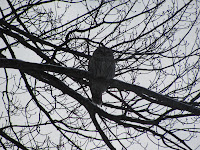Over the years these barred owls have come around mostly during the winter months, but occasionally in other seasons as well. One of them was sitting on a branch in the hemlock tree beside the house and appeared to be watching us in the house. The next morning I assumed that it had flown away. In the afternoon my daughter was coming home from school and asked why the owl was sleeping in the snow under the tree. I took it to a bird expert who informed me that owls often starve to death during the winter from lack of food. I think that is one of the reasons, all these years later, that I feed all the birds especially during the harsh winter months. Other than attracting the mice for them, I have not discovered another method for feeding the owls.
This update is a daytime picture of the barred owl in a oak tree. He should be sleeping!
SCIENTIFIC NAME Strix varia
CLASSIFICATION
SIZE
Class: Aves Order: Strigiformes Family: Strigidae Genus: Strix Species: varia
APPEARANCE: The Barred Owl is a medium-sized gray-brown owl that is streaked with white horizontal barring on the chest and vertical barring on the belly. They are round-headed with a whitish-brown facial disk that has brown trim. There are no feather tufts. The eyes are brown, and the beak is yellow and almost covered by feathers. The dark brown back is spotted with white and the long tail is crossed with six or seven sharply defined bands of pale brown. There is no difference in plumage between the males and the larger females.
Length: Male: 17-20 inches Female: 20-24 inches Weight: Male: 1-1 1/2 pounds Female: 1 1/2-1 3/4 pounds Wingspan: Male: 40-46 inches Female: 45-50 inches


No comments:
Post a Comment